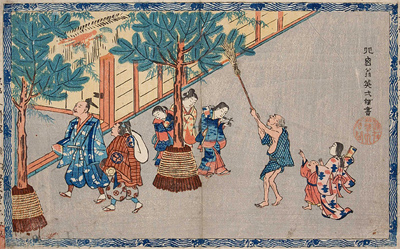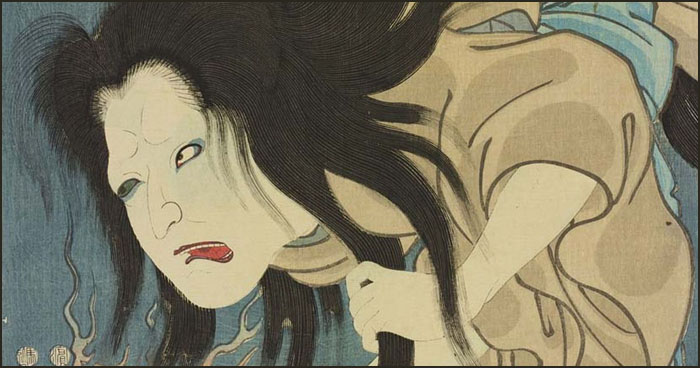[ . BACK to DARUMA MUSEUM TOP . ]
. - - - PERSONS - ABC - LIST of this BLOG - - - .
::::::::::::::::::::::::::::::
Hanabusa Itchoo, Itchō 英一蝶 Hanabusa Itcho / Iccho
(1652 – 1724)

富士山図 Mount Fujisan seen from river 相模川 Sagamigawa
Hanabusa means "Flower Bouquet"
Itcho means "One Butterfly"
- quote
Hanabusa Itchō (英 一蝶, 1652 – February 7, 1724)
was a Japanese painter, calligrapher, and haiku poet. He originally trained in the Kanō style, under Kanō Yasunobu, but ultimately rejected that style and became a literati (bunjin). He was also known as Hishikawa Waō and by a number of other art-names.
Born in Osaka and the son of the physician Taga Hakuan, he was originally named Taga Shinkō. Hakuan was the official doctor for Lord Ishikawa of the Kameyama Clan in the Ise region.
Itcho studied Kanō painting with Kano Yasunobu, but soon abandoned the school and his master to form his own style, which would come to be known as the Hanabusa school.
In 1693 was arrested and thrown into jail.
He was exiled in 1698, for parodying one of the shogun's concubines in painting, to the island of Miyake-jima; he would not return until 1710. That year, in Edo, the artist would formally take the name Hanabusa Itchō.
In 1709 Shogun Tsunayoshi died, and in honor of the new government, Itcho was granted pardon to come back to Edo.
Most of his paintings depicted typical urban life in Edo, and were approached from the perspective of a literati painter. His style, in-between the Kanō and ukiyo-e, is said to have been "more poetic and less formalistic than the Kanō school, and typical of the "bourgeois" spirit of the Genroku period".
Hanabusa was the master of the later painter Sawaki Suushi.
Hanabusa
was a friend of haiku poet Kikaku and studied poetry under the master Matsuo Bashō, his haikai name was Gyoun.
He was an excellent calligrapher as well.
- source : wikipedia -
..............................

Daruma 達磨
. Who is Daruma ? 達磨 だるまさん .
We have the story of a curtesan who commented about Daruma
"Well, he was sitting in quiet meditation for nine years, but we here have to sit and suffer in the Noisy Pleasure Quarters for more than ten years!"
The painter Hanabusa Itcho made a picture of the courtesan, which became the model of the Princess Daruma Dolls.
. Fujisan 富士山 Mount Fuji, Fuji-San .
Inrō in the Shape of Mount Fuji
18th–early 19th century - by Kajikawa School, based on a design by painter, calligrapher, and haiku poet Hanabusa Itchō (英 一蝶, 1652–1724).
..............................

The Life and Afterlives of Hanabusa Itchô, Artist-Rebel of EDO
(Japanese Visual Culture)
by Miriam Wattles
Miriam Wattles recounts the making of Hanabusa Itchô (1652-1724), painter, haikai-poet, singer-songwriter, and artist subversive, in The Life and Afterlives of Hanabusa Itcho, Artist-Rebel of Edo.
Translating literary motifs visually to encapsulate the tensions of his time, many of Itch s original works became models emulated by ukiyo-e and other artists. A wide array of sources reveals a lifetime of multiple personas and positions that are the source of his multifarious artistic reincarnations. While, on the one hand, his legend as seditious exile appears in the fictional cross-media worlds of theater, novels, and prints, on the other hand, factual accounts of his complicated artistic life reveal an important figure within the first artists biographies of early modern Japan."
- source : amazon.com -
- quote M. Wattles : -
I have worked extensively on Hanabusa Itchô, someone lauded from the Edo period through to Taisho for being the father of giga, and so spent some time excavating "giga" as a genre of the Edo period. (Discused in my book, The Life and Afterlives of Hanabusa Itchô, 2013,
and in my essay "From Adverb to Noun: Some Thoughts on Hanabusa Itchô and the Instability of the 'Giga' Genre"
in Ota Shôko, ed, Edo no shuppan bunka kara hajimatta imeeji kakumei," 2007)
- Follow the discussion here:
- source : PMJS listserve forum -
..............................

source : library.metro.tokyo.jp/portals
Twelve Months: New Year
英一蝶十二カ月の内 正月 Hanabusa Iccho Jūnikagetu no Uchi Shōgatsu
Painted by Hanabusa Icchō / Hanabusa Itcho

nunozarashi 布晒し Nuno Sarashi Mai-zu - Dancing with Cloth

"The Falling Thunder God"

一休和尚酔臥図 Ikkyu, the priest, lying down drunk
寝並んで小蝶と猫と和尚哉
ne narande kochoo to neko to oshoo kana
sleeping in a row ...
the little butterfly, the cat
and this old priest
. Kobayashi Issa 小林一茶 in Edo .
. oshoo 和尚 Buddhist priests in Haiku .
..............................
. Matsuo Basho 松尾芭蕉 - Archives of the WKD .
. Mingei 民芸 Folk Art from Japan .
. Welcome to Edo 江戸 ! .
::::::::::::::::::::::::::::::
- Reference - 英一蝶 -
- Reference - hanabusa itcho -
. Authors and writers of the Edo period .
. Introducing Japanese Haiku Poets .
::::::::::::::::::::::::::::::

Join the friends on facebook !
. - - - PERSONS - ABC - LIST of this BLOG - - - .
[ . BACK to DARUMA MUSEUM TOP . ]
[ . BACK to WORLDKIGO . TOP . ]
- - - #hanabusaitcho #hayabusa - - -
::::::::::::::::::::::::::::::
--
Posted By Gabi Greve to PERSONS - index - PERSONEN on 12/06/2016 09:40:00 am










































